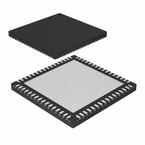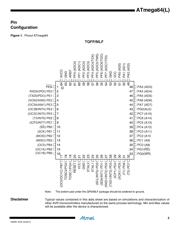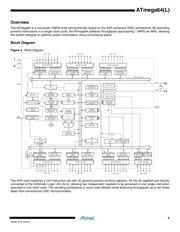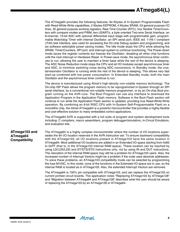Datasheet 搜索 > 8位微控制器 > Microchip(微芯) > ATMEGA64L-8MU 数据手册 > ATMEGA64L-8MU 用户编程技术手册 4/15 页

¥ 35.938
ATMEGA64L-8MU 用户编程技术手册 - Microchip(微芯)
制造商:
Microchip(微芯)
分类:
8位微控制器
封装:
VFQFN-64
描述:
8位 MCU微控制单元, 低功率高性能, AVR ATmega Family ATmega64 Series Microcontrollers, 8 MHz, 64 KB, 4 KB, 64 引脚
Pictures:
3D模型
符号图
焊盘图
引脚图
产品图
页面导航:
导航目录
ATMEGA64L-8MU数据手册
Page:
of 15 Go
若手册格式错乱,请下载阅览PDF原文件

4
2490R–AVR–02/2013
ATmega64(L)
The ATmega64 provides the following features: 64 Kbytes of In-System Programmable Flash
with Read-While-Write capabilities, 2 Kbytes EEPROM, 4 Kbytes SRAM, 53 general purpose I/O
lines, 32 general purpose working registers, Real Time Counter (RTC), four flexible Timer/Coun-
ters with compare modes and PWM, two USARTs, a byte oriented Two-wire Serial Interface, an
8-channel, 10-bit ADC with optional differential input stage with programmable gain, program-
mable Watchdog Timer with internal Oscillator, an SPI serial port, IEEE std. 1149.1 compliant
JTAG test interface, also used for accessing the On-chip Debug system and programming, and
six software selectable power saving modes. The Idle mode stops the CPU while allowing the
SRAM, Timer/Counters, SPI port, and interrupt system to continue functioning. The Power-down
mode saves the register contents but freezes the Oscillator, disabling all other chip functions
until the next interrupt or Hardware Reset. In Power-save mode, the asynchronous timer contin-
ues to run, allowing the user to maintain a timer base while the rest of the device is sleeping.
The ADC Noise Reduction mode stops the CPU and all I/O modules except asynchronous timer
and ADC, to minimize switching noise during ADC conversions. In Standby mode, the crys-
tal/resonator Oscillator is running while the rest of the device is sleeping. This allows very fast
start-up combined with low power consumption. In Extended Standby mode, both the main
Oscillator and the asynchronous timer continue to run.
The device is manufactured using Atmel’s high-density non-volatile memory technology. The
On-chip ISP Flash allows the program memory to be reprogrammed In-System through an SPI
serial interface, by a conventional non-volatile memory programmer, or by an On-chip Boot pro-
gram running on the AVR core. The Boot Program can use any interface to download the
Application Program in the Application Flash memory. Software in the Boot Flash section will
continue to run while the Application Flash section is updated, providing true Read-While-Write
operation. By combining an 8-bit RISC CPU with In-System Self-Programmable Flash on a
monolithic chip, the Atmel ATmega64 is a powerful microcontroller that provides a highly-flexible
and cost-effective solution to many embedded control applications.
The ATmega64 AVR is supported with a full suite of program and system development tools
including: C compilers, macro assemblers, program debugger/simulators, In-Circuit Emulators,
and evaluation kits.
ATmega103 and
ATmega64
Compatibility
The ATmega64 is a highly complex microcontroller where the number of I/O locations super-
sedes the 64 I/O location reserved in the AVR instruction set. To ensure backward compatibility
with the ATmega103, all I/O locations present in ATmega103 have the same location in
ATmega64. Most additional I/O locations are added in an Extended I/O space starting from 0x60
to 0xFF (that is, in the ATmega103 internal RAM space). These location can be reached by
using LD/LDS/LDD and ST/STS/STD instructions only, not by using IN and OUT instructions.
The relocation of the internal RAM space may still be a problem for ATmega103 users. Also, the
increased number of Interrupt Vectors might be a problem if the code uses absolute addresses.
To solve these problems, an ATmega103 compatibility mode can be selected by programming
the fuse M103C. In this mode, none of the functions in the Extended I/O space are in use, so the
internal RAM is located as in ATmega103. Also, the extended Interrupt Vectors are removed.
The ATmega64 is 100% pin compatible with ATmega103, and can replace the ATmega103 on
current printed circuit boards. The application notes “Replacing ATmega103 by ATmega128”
and “Migration between ATmega64 and ATmega128” describes what the user should be aware
of replacing the ATmega103 by an ATmega128 or ATmega64.
器件 Datasheet 文档搜索
AiEMA 数据库涵盖高达 72,405,303 个元件的数据手册,每天更新 5,000 多个 PDF 文件







